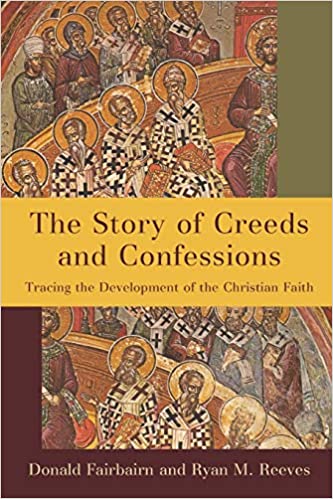A Brief Book Summary from Books at a Glance
By Mark Baker
About the Editors
Donald Fairbarn (PhD, University of Cambridge) is the Robert E. Cooley Professor of Early Christianity at Gordon-Conwell Theological Seminary. Ryan M. Reeves (PhD, University of Cambridge) has taught at Gordon-Conwell Theological Seminary, Reformed Theological Seminary, Orlando, and the University of Cambridge (back cover).
Overview of the Book
This book, as its title suggests, provides an overview of the story of creeds and confessions. Creeds are more vertically focused; they look towards God and define our relationship before him. Confessions are more horizontally focused; they define the communities in which we are a part. But both creeds and confessions are not dry, dusty words that have no life to them. In fact, to study the creeds and confessions is to study the story of God’s faithfulness to his people throughout the Christian church. It is this story that we seek to tell in this book.
Table of Contents
- Beginning the Story
PART 1: THE ERA OF THE CREEDS (100–500)
- The Creedal Impulse in Scripture and the Early Church
- A Christian Empire and Creedal Standardization
- The Nicene Creed: A Creed for the Entire Church
- The Chalcedonian Definition: Explaining the Nicene Creed
- The Apostles’ Creed: A Regional Creed with Traditional Authority
- The Athanasian Creed: A Creedal Anomaly with Staying Power
PART 2: EXPLORING CREEDAL THEOLOGY (500–900)
- Clarifying Chalcedon in the East
- The West Charts Its Own Theological Course
- Creedal Dissension in the East-West Schism
PART 3: FROM CREEDS TO CONFESSIONS IN THE WEST (900–1500)
- Setting the Stage for Medieval Developments
- Catholic Confessions in the High Middle Ages
PART 4: THE REFORMATION AND CONFESSIONALISM (1500–1650)
- The Crisis of the Reformation
- Early Protestant Confessions
- New Generations of Protestant Confessions
- Catholic and Orthodox Responses to Protestant Confessions
- Protestant Confessions in the Late Reformation
PART 5: CONFESSIONS IN THE MODERN WORLD (1650–PRESENT)
- The New Grammar of Modern Confessions
Summary
Chapter 1: Beginning the Story
The heart of Christianity is not a summary of commandments to follow or propositions to believe. At the heart of Christianity is a name: “There is no other name under heaven given among men by which we must be saved” (Acts 4:12). As we begin this study of creeds and confessions, we want to make clear that this study is meant to—above all else—illuminate Jesus Christ, the Son of the living God. A thorough study of the creeds and confessions also helps guard against the unhelpful extremes of biblicism and individualism. Biblicism claims that “there is no creed but the Bible.”
Ironically, this extra-biblical statement serves as a creed itself, yet it is a creed that provides little guidance toward orthodoxy. Similarly, individualism claims a “just me and Jesus” kind of spirituality that ignores the faithful saints who have gone before us. In response to these two unhelpful extremes, we should look to the historic creeds and confessions to help us treasure the “faith that was once for all delivered to the saints” (Jude 3).
PART 1: THE ERA OF THE CREEDS (100–500)
Chapter 2: The Creedal Impulse in Scripture and the Early Church
The early church did not invent creeds. We even see short “creedal” statements in the Old Testament, such as the shema of Deuteronomy 6:4. The New Testament also includes many creed-like statements (e.g. 1 Cor 15:3–4; Phil 2:5–11; 2 Cor 13:14), and this trend continued into the second and third centuries. The creeds consistently focus on the Trinity and the saving work of Jesus Christ.
[To continue reading this summary, please see below....]The remainder of this article is premium content. Become a member to continue reading.
Already have an account? Sign In
